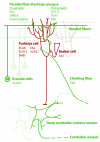Physiologic alterations in ataxia: channeling changes into novel therapies
- PMID: 19822774
- PMCID: PMC2762109
- DOI: 10.1001/archneurol.2009.212
Physiologic alterations in ataxia: channeling changes into novel therapies
Abstract
The ataxias constitute a heterogeneous group of diseases in which cerebellar dysfunction typically underlies the major neurologic manifestations. It is increasingly clear that ataxia can result directly from mutations in ion channels or from perturbations in ion channel physiology in the absence of a primary channel defect. Neuronal dysfunction stemming from perturbed channel activity likely explains some motor deficits in episodic and degenerative ataxias. Understanding these pathophysiologic changes may reveal novel therapeutic targets for symptomatic treatment of ataxia.
Figures


References
-
- Jen JC. Hereditary episodic ataxias. Ann N Y Acad Sci. 2008 Oct;1142:250–253. - PubMed
-
- Kordasiewicz HB, Gomez CM. Molecular pathogenesis of spinocerebellar ataxia type 6. Neurotherapeutics. 2007 Apr;4(2):285–294. - PubMed
-
- Kordasiewicz HB, Thompson RM, Clark HB, Gomez CM. C-termini of P/Q-type Ca2+ channel alpha1A subunits translocate to nuclei and promote polyglutamine-mediated toxicity. Hum Mol Genet. 2006 May 15;15(10):1587–1599. - PubMed

